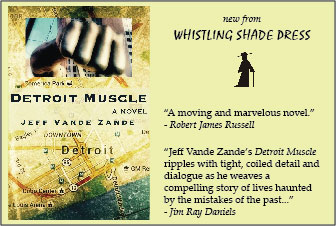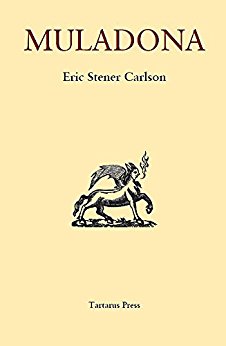
| <- Back to main page |

|
(Tartarus Press)
A muladona is an obscure mythological centaur-like creature from Catalan mythology: half woman, half mule, the beast is said to enter mule trains and frighten them to stampede. A similar hybrid, the almamula, hails from Argentina. Eric Stener Carlson borrows from this Spanish folk background to craft his own terrifying Muladona, a winged mule-woman demon who repeatedly visits Vergil Strömberg, a boy who is abandoned by his family in the fictional town of Incarnation, Texas, during the Spanish Flu outbreak of 1918. The Muladona visits only after midnight, and Vergil’s only escape is to cower under his bedsheets while the creature recites a horror story in its rasping voice.

Then I heard the scratching, scraping sound of chains being dragged along the hallway, and all my hope vanished. I closed my eyes and rolled myself into a ball, praying that God would give me the strength to endure one more night. The dank, grave-like smell permeated the air as the awful creature clip-clopped its way into my room.
Like Carlson’s first novel, The St Perpetuus Club of Buenos Aires, Muladona is dark and atmospheric, a literate horror story that contains puzzles strewn amid a rich background layered by Apache folklore, legends of the Spanish conquistadores, and the puritanical religion imposed by Vergil’s grandfather, a Swedish missionary. We first learn of the Muladona from a story told by Carlos, a Hispanic neighbor who gardens for the Strömbergs. After Vergil’s mother disappears and older brother Sebas leaves home, his fire-and-brimstone preacher of a father is called to another town to substitute for its pastor; even the old housekeeper, Lupita, runs off to attend a sister down with the flu. It is then that the visitation of the Muladona begins. On the first night it lays out the rules of the game:
‘For seven nights, I will vi-isit you. Each night, I’ll tell you a beed-time story. Wrapped within the sto-ories are clues to the ideentity of the person who takes the form of this mi-ighty creature you see before you. A-any time you like, you can throw back the sheets and tell me who you think I am. If you’re sma-art enough, Poof! I disappear, and you never have to see me again.’
Vergil’s only ally left is Carlos’ daughter, his childhood friend Carolina.
Carolina gulped hard and said, ‘No one deserves this, Verge. It’s blind luck. Death’s like that roulette wheel we saw in the gambling hall. When your number’s up, it’s up. That’s what our boys fightin’ in France are up against. Some’re gonna come home, some ain’t.’ She squeezed my hand and said, ‘But so long as you got breath in your lungs and fight in your body, it ain’t over...’
The Muladona’s stories are related in full by their horrified listener, forming a significant part of the book. Though not as terrifying as their effect on Verge would suggest, the tales are fascinating little narratives in their own respect. In one, a beautiful damsel in distress turns out to be a succubus; another tells the tale of a cemetery caretaker who finds he can communicate with a voluptuous bronze funerary statue.
Muladona’s story-within-a-framework structure recalls the Decameron of Boccaccio, though the dark tone is more reminiscent of Dante. It’s a dense tangle of cruelty, anguish, intrigue and history run riot that would be worthy of Borges himself. Yet at heart it’s still an urban legend, a simple nightmare about a boy who pulls his sheets over his head to hide from the monster. The deep crevasse Carlson tries to bridge here—between Great Literature and pulp fiction, erudition and the id—is a bit of a stretch, but Muladona remains a fascinating read, even if you don’t particularly care for Stephen King.
- Joel Van Valin 